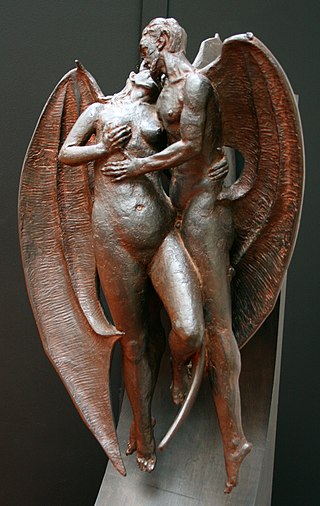
A devil is the personification of evil as it is conceived in various cultures and religious traditions. It is seen as the objectification of a hostile and destructive force. Jeffrey Burton Russell states that the different conceptions of the devil can be summed up as 1) a principle of evil independent from God, 2) an aspect of God, 3) a created being turning evil, and 4) a symbol of human evil.

Satan, also known as the Devil, and sometimes also called Lucifer in Christianity, is an entity in Abrahamic religions that seduces humans into sin or falsehood. In Judaism, Satan is seen as an agent subservient to God, typically regarded as a metaphor for the yetzer hara, or "evil inclination". In Christianity and Islam, he is usually seen as a fallen angel or jinn who has rebelled against God, who nevertheless allows him temporary power over the fallen world and a host of demons. In the Quran, Shaitan, also known as Iblis, is an entity made of fire who was cast out of Heaven because he refused to bow before the newly created Adam and incites humans to sin by infecting their minds with waswās.
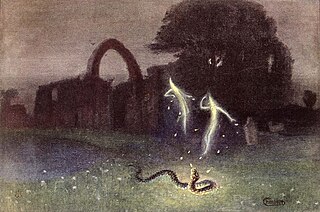
In folklore, a will-o'-the-wisp, will-o'-wisp, or ignis fatuus, is an atmospheric ghost light seen by travellers at night, especially over bogs, swamps or marshes. The phenomenon is known in much of European folklore by a variety of names, including jack-o'-lantern, friar's lantern, and hinkypunk, and is said to mislead travellers by resembling a flickering lamp or lantern. In literature, will-o'-the-wisp metaphorically refers to a hope or goal that leads one on, but is impossible to reach, or something one finds strange or sinister. Wills-o'-the-wisp appear in folk tales and traditional legends of numerous countries and cultures; notable named examples include St. Louis Light in Saskatchewan, the Spooklight in Southwestern Missouri and Northeastern Oklahoma, the Marfa lights of Texas, the Naga fireballs on the Mekong in Thailand, the Paulding Light in Upper Peninsula of Michigan, and the Hessdalen light in Norway.

Memnoch the Devil (1995) is a vampire novel novel by American writer Anne Rice, the fifth in her Vampire Chronicles series, following The Tale of the Body Thief. In this story, Lestat is approached by the Devil and offered a job at his side.

Samael is an archangel in Talmudic and post-Talmudic lore; a figure who is the accuser or adversary, seducer, and Destroying angel.

A jack-o'-lantern is a carved lantern, most commonly made from a pumpkin, or formerly a root vegetable such as a mangelwurzel, rutabaga or turnip. Jack-o'-lanterns are associated with the Halloween holiday. Its name comes from the phenomenon of strange lights flickering over peat bogs, called jack-o'-lanterns. It is suggested that the name also has ties to the Irish legend of Stingy Jack, a drunkard who bargains with Satan and is doomed to roam the Earth with only a hollowed turnip to light his way.

Fallen angels are angels who were expelled from Heaven. The literal term "fallen angel" does not appear in any Abrahamic religious texts, but is used to describe angels cast out of heaven or angels who sinned. Such angels often tempt humans to sin.
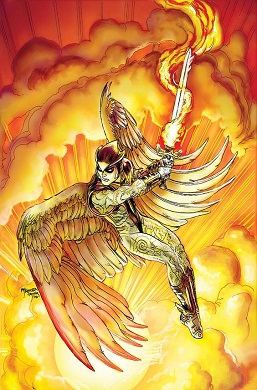
Zauriel is a fictional superhero in the DC Universe. Originally a guardian angel who served Heaven for millions of years, he willingly falls to Earth to serve humanity as their champion and joins the Justice League.

Little Nicky is a 2000 American fantasy comedy film directed by Steven Brill, written by Tim Herlihy, Adam Sandler, and Brill, and starring Sandler in the title role, Patricia Arquette, Harvey Keitel, Tommy "Tiny" Lister Jr., Rhys Ifans, and Rodney Dangerfield with supporting roles by Allen Covert, Kevin Nealon, Jon Lovitz, Michael McKean, and Quentin Tarantino.

Neron is a supervillain appearing in various American comic book stories published by DC Comics. He first appeared in Underworld Unleashed #1 and was created by Mark Waid and Howard Porter.
The Devil, appears frequently as a character in literature and various other media. In Abrahamic religions, the figure of the Devil, Satan personifies evil.

Dean Winchester is one of the two protagonists from the American drama television series Supernatural, along with his younger brother Sam. He is portrayed primarily by Jensen Ackles. Other versions of the character having been portrayed by Hunter Brochu (toddler), Ridge Canipe (child), Nicolai Lawton-Giustra (pre-teen), Brock Kelly and Dylan Everett (teen), and Chad Everett (elderly).
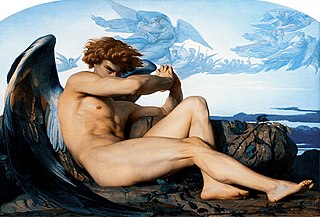
In Christianity, the Devil is the personification of evil. He is traditionally held to have rebelled against God in an attempt to become equal to God himself. He is depicted as a fallen angel, who was expelled from Heaven at the beginning of time, before God created the material world, and is in constant opposition to God. The devil is conjectured to be several other figures in the Bible including the serpent in the Garden of Eden, Lucifer, Satan, the tempter of the Gospels, Samael, and the dragon in the Book of Revelation.

Akuma na Eros, also known as Virgin Crisis, is a Japanese shōjo manga series by Mayu Shinjo. It was serialized in 17 chapters by Shogakukan in the biweekly manga magazine Shōjo Comic in 2001, and collected in four tankōbon volumes. It depicts the romance between a high-school girl, Miu, and Satan.
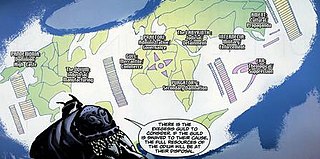
Hell is a fictional location, an infernal Underworld utilized in various American comic book stories published by DC Comics. It is the locational antithesis of the Silver City in Heaven. The DC Comics location known as Hell is heavily based on its depiction in Abrahamic mythology. Although several versions of Hell had briefly appeared in other DC Comics publications in the past, the official DC Comics concept of Hell was first properly established when it was mentioned in The Saga of the Swamp Thing #25–27 and was first seen in Swamp Thing Annual #2 (1985), all of which were written by Alan Moore and illustrated by Stephen Bissette and John Totleben.
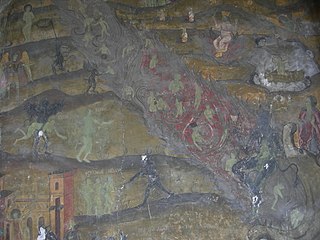
"Ivan Turbincă" is an 1880 short story, fairy tale and satirical text by Romanian writer Ion Creangă, echoing themes common in Romanian and European folklore. It recounts the adventures of an eponymous Russian soldier, who passes between the world of the living, Heaven and Hell, on a quest for immortality. In the beginning of the story, God rewards Ivan's charitable nature with a pouch with which he can trap all things in existence, and used by the soldier to subdue Satan and the multitude of devils, and eventually serve his purpose of cheating Death. The text also includes a portrayal of Saint Peter as the gatekeeper of Heaven, a reference to the miraculous powers of Saint Nicholas, as well as humorous references to the lifestyle of local aristocrats, or boyars. The protagonist himself is shown to be devoted and intelligent, but is primarily motivated by partying and drinking, activities which he engages in for eternity.

Blue Devil is a superhero appearing in American comic books published by DC Comics. He first appeared in a special insert published in Fury of Firestorm #24. That story led directly into Blue Devil #1, also cover dated June 1984. He was created by Dan Mishkin, Gary Cohn, and Paris Cullins. The Blue Devil comic book ran for 31 issues and one annual. Blue Devil later appeared as a regular character in Shadowpact which ran for 25 issues.
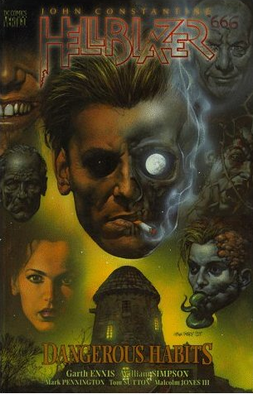
Dangerous Habits is a six-issue Hellblazer story arc written by Garth Ennis with art by Will Simpson, published by DC Comics, later under their Vertigo imprint. Dangerous Habits comprises issues #41-46 of the Hellblazer series. The story features occult detective John Constantine contracting terminal lung cancer and attempting to con the Lords of Hell into curing it.
Angel of the Lord is a 2005 Czech fantasy comedy film directed by Jiří Strach. Based on folk tales by Božena Němcová, it tells the story of a ne'er-do-well angel who descends to Earth to prove himself and in the process, saves his own soul.
















